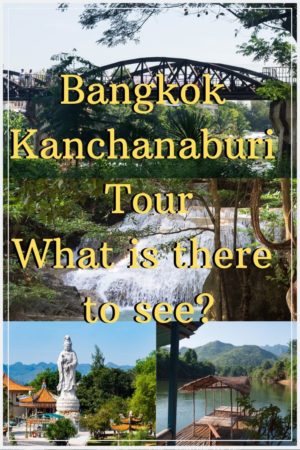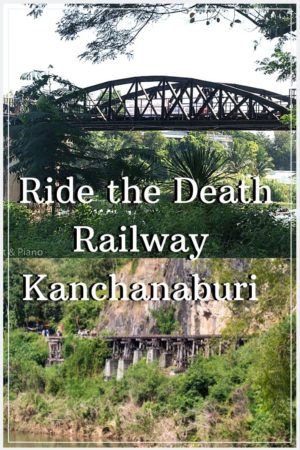The Kanchanaburi province became famous by the award-winning film, Bridge over the River Kwai and If your visiting Thailand it’s well worth exploring the are. The easiest way to do that is, either by joining a Bangkok Kanchanaburi tour or Kanchanaburi day trip.
If you’ve had enough of the hustle and bustle of Bangkok the capital of Thailand, Kanchanaburi is the perfect place to visit.
The area of Kanchanaburi is not only steeped in World War II history it’s also stunningly beautiful.
Its one of Bangkok’s top 10 attractions, but with so much to see how do you choose the best Kanchanaburi tour from Bangkok?
Well, Passport and Piano is here to help. Within this post, you’ll find all the information you need to book a Kanchanaburi day trip from Bangkok, a Kanchanaburi package tour or plan your own Kanchanaburi itinerary.
You may also be interested in reading this article on the best hotels in Kanchanaburi.
This article may contain compensated links. Please read my disclaimer policy for more info.
I suggest you start by reading the comparison charts and then go onto the guide for more information about the attractions.
Comparison Chart From Bangkok day trips to Kanchanaburi
| Tour With |
Jeath War Museum |
War Graves |
River Kwai Bridge |
Train Ride |
Hell fire Pass |
Erawan Falls |
Other | Cost |
|---|---|---|---|---|---|---|---|---|
| Tour East |
✅ |
✅ |
✅ |
✅ | ❌ | ❌ | Boat Ride |
|
| MAM Hols |
❌ |
❌ |
✅ |
❌ | ❌ | ✅ | Bamboo Rafting |
|
| Viator |
✅ |
✅ |
✅ |
✅ | ❌ | ❌ | ❌ | |
| GYG |
❌ |
❌ |
✅ |
✅ | ❌ | ✅ | Krasae Cave |
While a visit to Kanchanaburi on a Bangkok 1 day tour is fantastic if you’re short of time there are some negatives.
Negatives on a Bangkok to Kanchanaburi day tour
- Long Day
- Not enough time at attractions
- You have to compromise on what you see
A Bangkok tour package to Kanchanaburi solves these problems, and they offer great value for money.
Comparison Chart of overnight Kanchanaburi from Bangkok Tours
🍎- Damnoen Saduak Floating Market 🏘-Mon Tribal Village. R – Raftingafting
🌉- Bridge over River Kwai 🐘-Elephant World 🛤-Tham krasae
🎚-War Cemetary 🏛Thailand-Burma War Museum. 🏞-Soi yok Noi
🚂 -Ride Death Railway Train 🍙-Krasae Caves 🏯-Wat Tham Sua
🔥-Hellfire Pass 🛶-Kayak on River Kwai ♨︎ – Pung Wann
💦-Erawan Falls ⛵️-Long Boat Cruise or Hin Dad Hot Springs
| Tour With |
Hotel | 🍎 | 🌉 | 🎚 | 🚂 | 🔥 | 💦 | 🏘 | 🐘 | 🏛 | 🍙 | 🛶 | ⛵️ | R | 🛤 | 🏞 | 🏯 | ♨︎ | Cost |
|---|---|---|---|---|---|---|---|---|---|---|---|---|---|---|---|---|---|---|---|
| Viator 2 days |
Floating Raft hotel |
❌ |
❌ |
❌ |
❌ | ✅ | ✅ | ❌ | ✅ | ✅ | ✅ | ✅ | ✅ | ✅ | ✅ | ✅ | ✅ | ✅ | |
| Viator 2 day |
River Kwai Resotel |
❌ |
✅ |
✅ |
✅ | ✅ | ❌ | ✅ | ❌ | ✅ | ❌ | ❌ | ✅ | ❌ | ❌ | ❌ | ✅ | ❌ | |
| Viator 2 day |
River Kwai Jungle Rafts |
✅ |
✅ |
❌ |
✅ | ✅ | ✅ | ✅ | ❌ | ✅ | ✅ | ❌ | ✅ | ❌ | ❌ | ❌ | ✅ | ❌ | |
| GYG 2 Day |
4* Hotel optional extra |
✅ |
✅ |
✅ |
✅ | ❌ | ✅ | ❌ | ❌ | ✅ | ✅ | ❌ | ✅ | ❌ | ❌ | ❌ | ✅ | ❌ | |
| True Asia Travels 2 Day |
River Kwai Resort |
✅ |
✅ |
✅ |
✅ | ✅ | ✅ | ❌ | ❌ | ✅ | ❌ | ❌ | ❌ | ❌ | ✅ | ❌ | ❌ | ✅ | |
| Tour East 3 Day |
River Kwai Resotel |
❌ |
❌ |
✅ |
✅ | ✅ | ❌ | ✅ | ❌ | ✅ | ❌ | ❌ | ✅ | ❌ | ❌ | ❌ | ❌ | ❌ | |
| Amazing Asia Tours 3 Day |
River Kwai Jungle Rafts |
✅ |
✅ |
✅ |
❌ | ✅ | ❌ | ❌ | ✅ | ✅ | ❌ | ❌ | ✅ | ❌ | ❌ | ❌ | ❌ | ✅ |
While comparison charts are useful to compare tours to Kanchanaburi from Bangkok, you still might feel like your none the wiser as to which Kanchanaburi tours will suit your needs best.
Don’t worry the next part of this guide gives you all the information on Kanchanaburi attractions.
What are the Best Things to do in Kanchanaburi?
All the attractions mentioned in the comparison charts are detailed below. A ⭐️ marks the top places to visit.
Bridge Over River Kwai ⭐️
Of course, this is one of the main reasons people flock here and as expected the area around the bridge is rather busy. There are market stalls selling tourist souvenirs and plenty of food stalls.
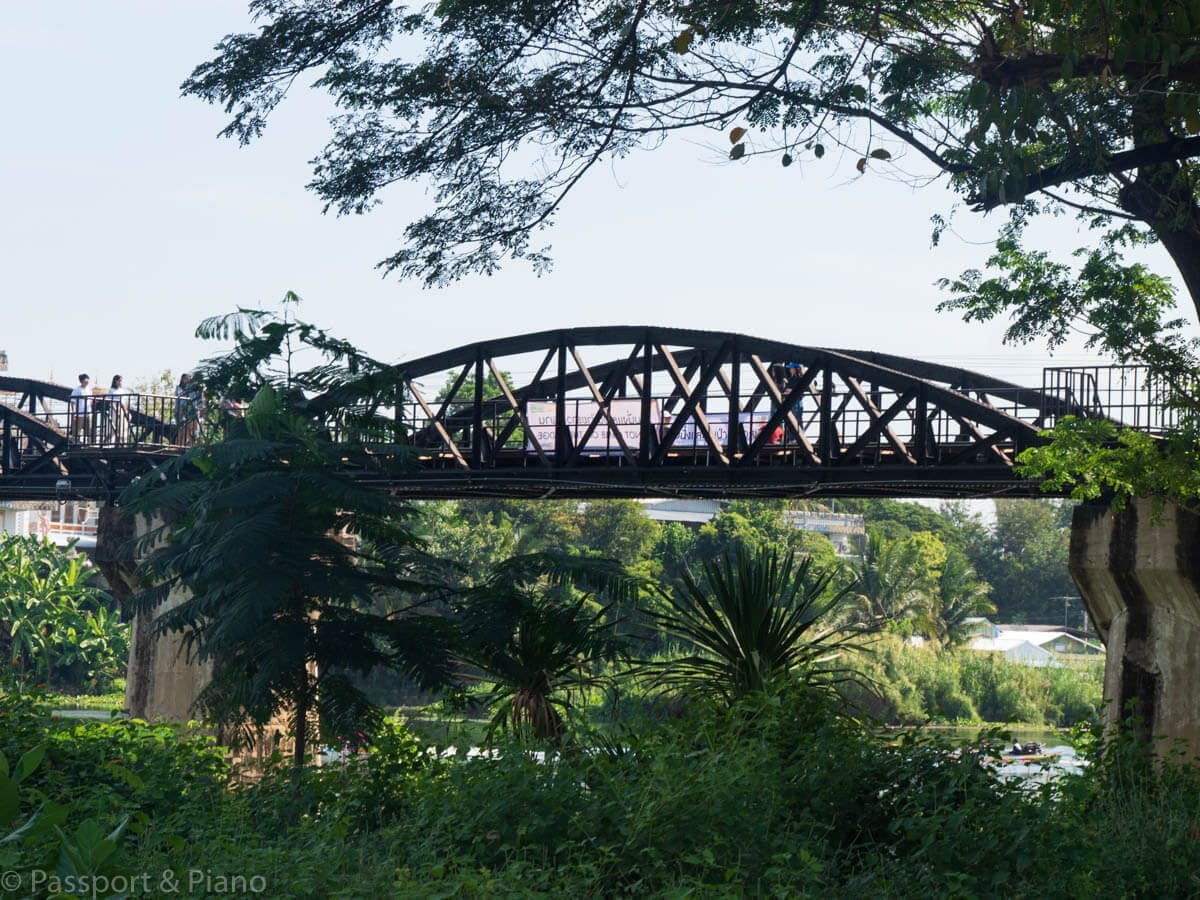
The bridge was made famous by the 1957 Film Bridge over the River Kwai.
However, the facts put across in the film are somewhat inaccurate. The Kanchanaburi bridge that tourists now flock to see is actually over the river Mae Khlung, but following the success of the film the Thais wisely renamed the river Kwae.
The allied forces bombed the bridge in 1945 so only parts of the steel bridge today are original.
That aside the bridge is a prominent structure and serves as a reminder to us all of the tragedies that sadly occurred in the building of the railway.
As you walk across the bridge away from the town, it gets quieter, and there are actually a few people who go as far as Kanchanaburi train station.
Click here If for more information on the best hotels near the Bridge over the River Kwai.
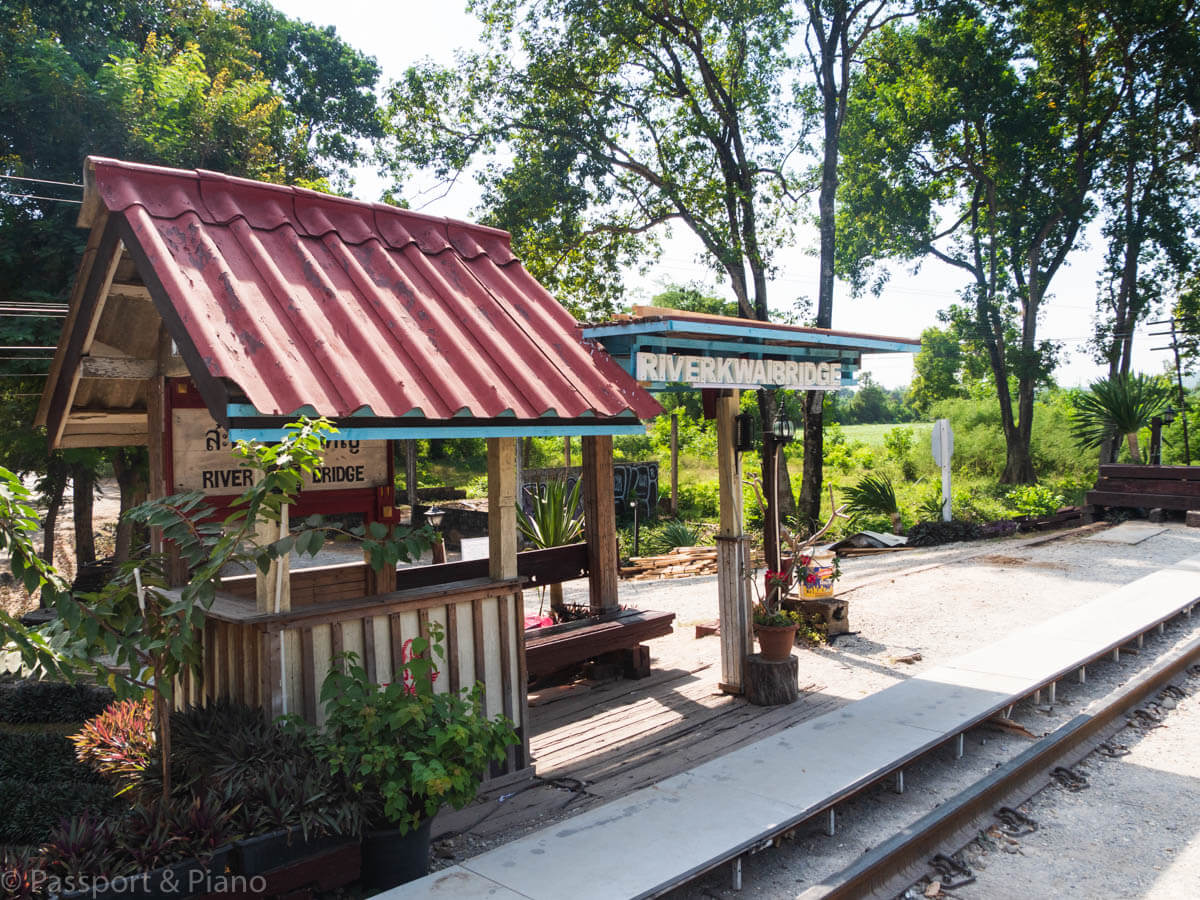
Interestingly this little station hut is not where you board the train for the Kanchanaburi death railway journey.
Kung Im Temple
The Kung Im temple is located next to the River Kwai bridge on the right-hand side as you cross it.
You’ll be able to see the giant (55ft) white Buddhist statue of 55ft of Guanyin, the construction of which was somewhat controversial because of its size and blot on the landscape.
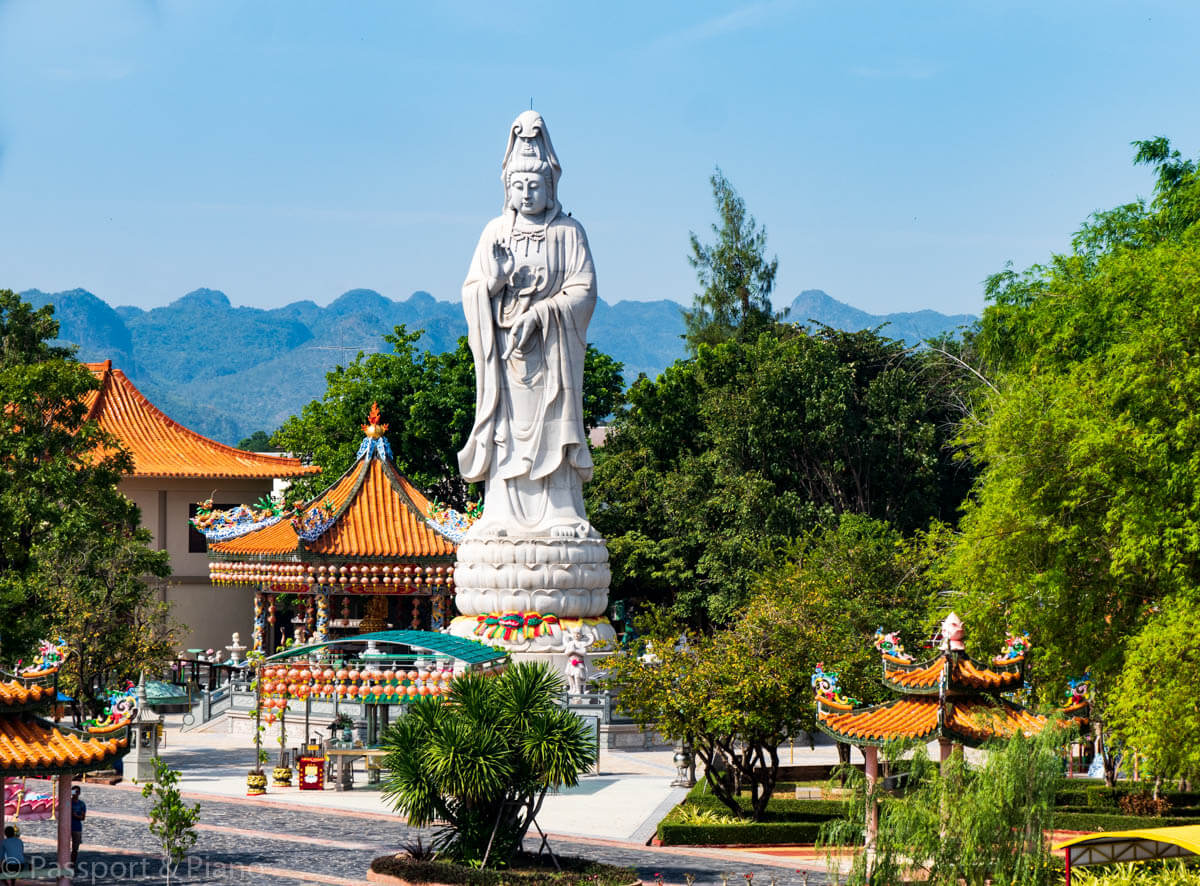
Interestingly no tours visit the Kung Im or statue of Guan Yin Temple. However, the temple and gardens are well worth a visit for both their beauty and fantastic views of the bridge.
To access the temple head over the bridge and turn right. As you walk around the grounds it’s incredibly peaceful and calm.
There are numerous colourful pagodas and intriguing statues to admire.
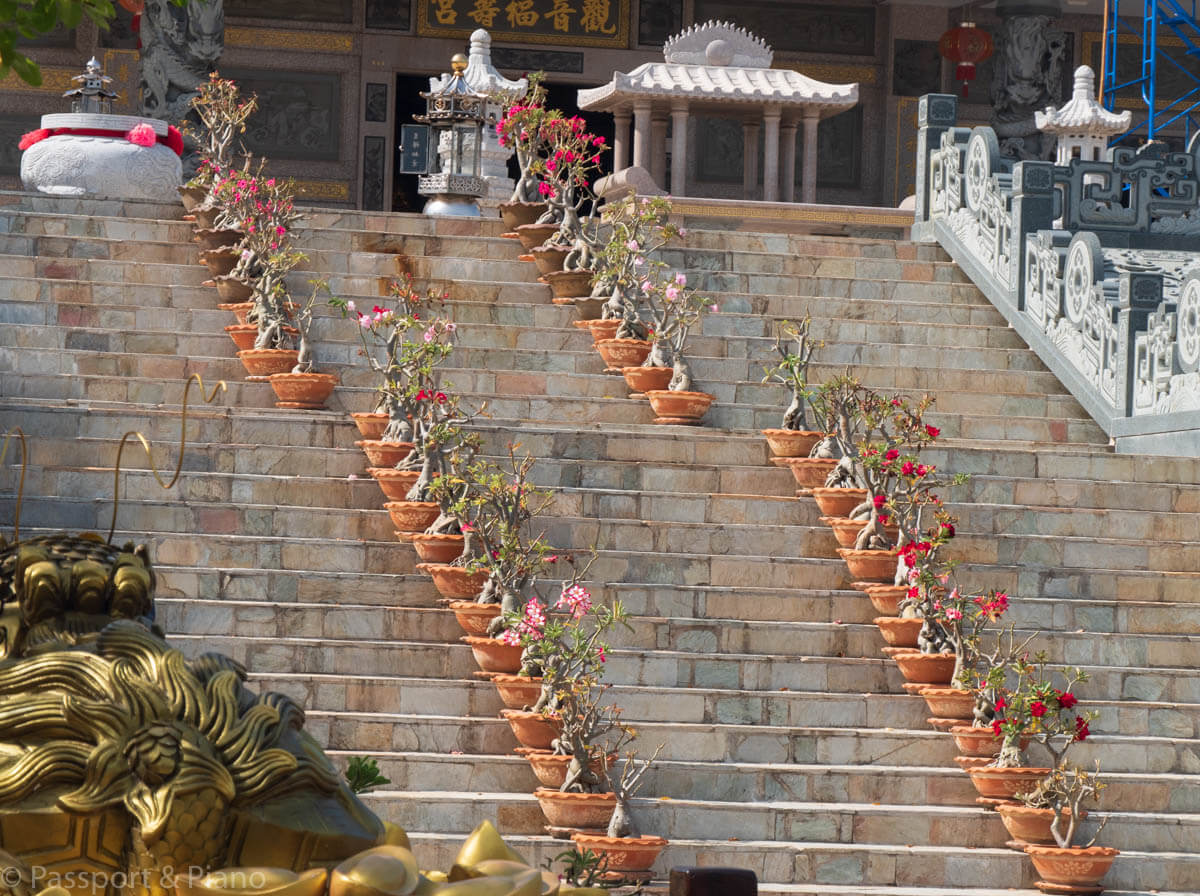
On the steps leading to the entrance of the main temple, there is a delightful collection of Bonsai Trees.
With plenty of places to sit, its a great place to relax and contemplate the historical events of this area.
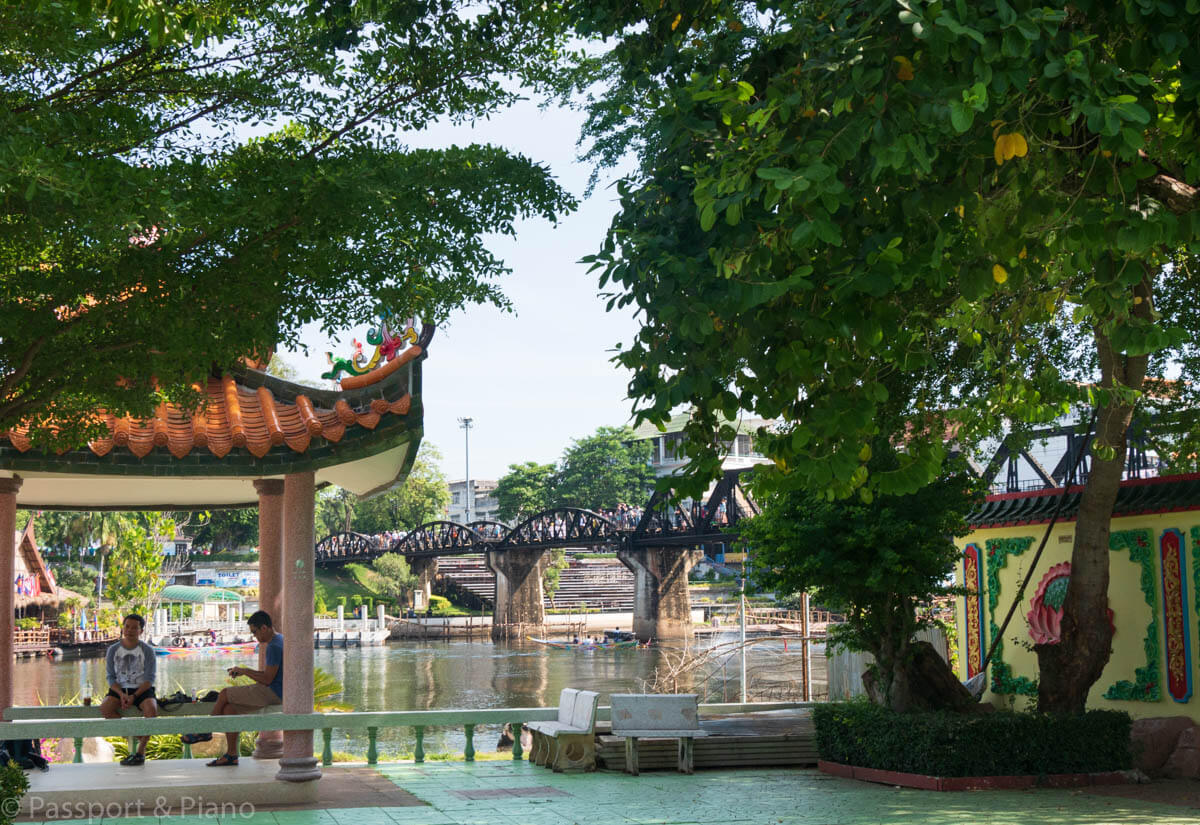
Jeath War Museum
Jeath is an abbreviation of Japan, England, Australia/America, Thailand and Holland
This is a bizarre museum, but it seems to be part of the itinerary on all Bangkok day tours to Kanchanaburi. However, unless you’ve got time to spare, I’d give it a miss. I was disappointed and annoyed at the shambolic nature of this establishment.
There seemed to be no proper layout and exhibits were nothing short of random, with many of the objects displayed bearing no resemblance to the war.
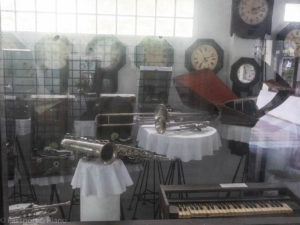
There wasn’t much to read in English, and the lighting was such that it felt dark and dingy throughout.
On the plus side, the buildings from the courtyard have beautiful facades, and you get a great view over the river Kwai and bridge.
For those who like automotive relics, there’s also a helicopter and a train engine which is of some interest.
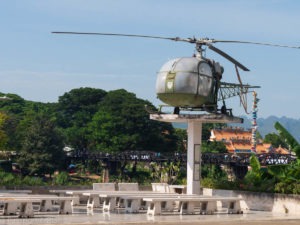
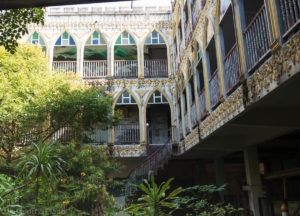
Is it worth going in? Probably not but it’s good to see it for yourself and if like me you don’t want to miss anything, it perhaps worth a quick look around.
I did purchase a hand-carved soap in a lovely box which was cheaper than those sold on the local market. The entry fee is 30 baht.
The Thailand-Burma Railway Centre
This is a small museum that’s well worth a visit although it’s often not included in day trips from Bangkok. You’ll find the Museum of Death as it’s sometimes referred to near the War Cemetery.
It’s a cream building on the right-hand side with a banner stretching the whole width which reads “ The Death Railway museum. The entrance fee is 150 Baht, and the displays are much better kept than the ones in the Jeath Museum. There’s also a cafe and a shop to peruse around.
Kanchanaburi War Cemetery
As soon as you see this sight the stark devastation of world war two has a profound effect on you.
There are 6982 PWO (prisoners of war) buried here, mostly Australian, Dutch and British. As you walk around you can’t help but get emotional, there are so many plaques to read its overwhelming.
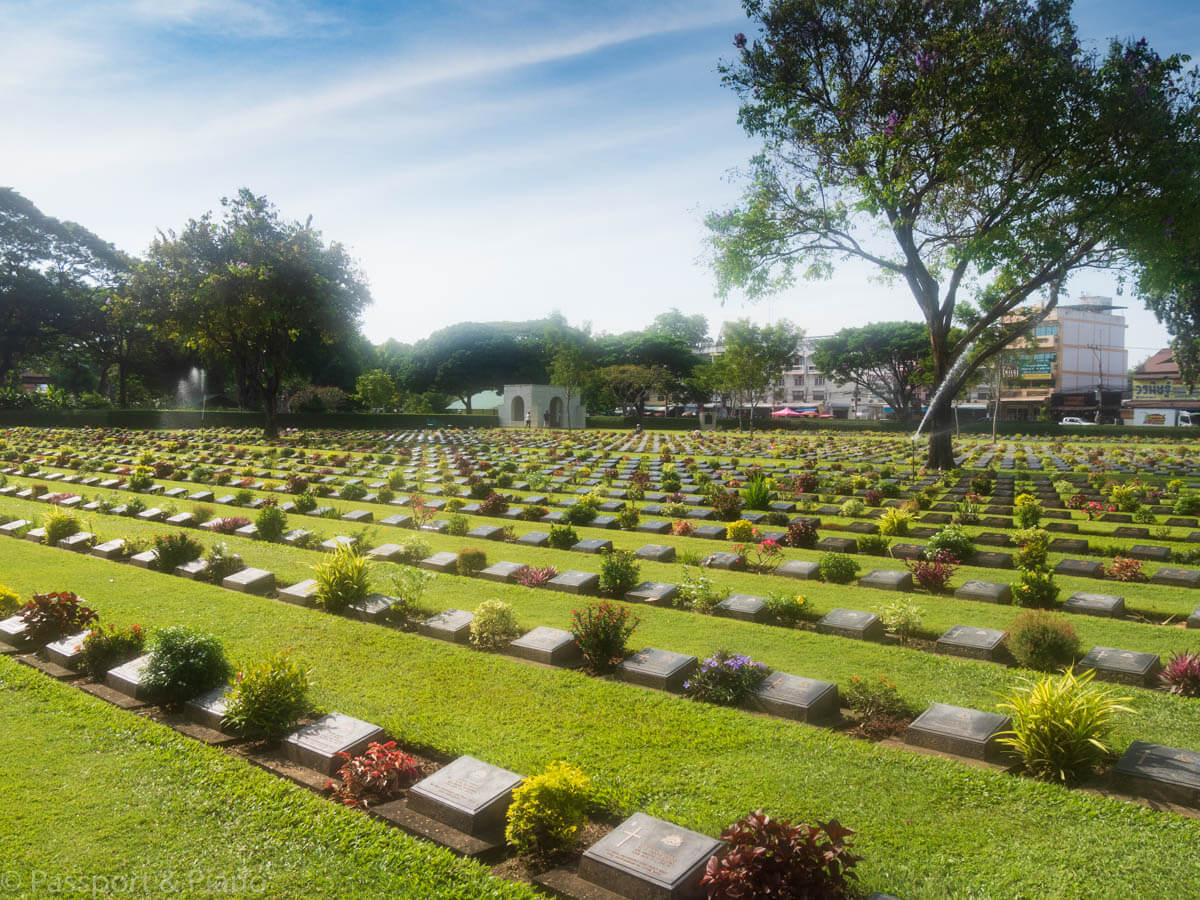
The men named on them are so noticeably young. Seeing several graves from my hometown Manchester was particularly heart wrenching.
The Kanchanaburi Cemetery is immaculately kept and maintained by the commonwealth war graves commission. The cemetery is free to visit and is situated on the left of the main road if you’re coming from Bangkok towards Kanchanaburi city.
The Commonwealth War Graves Commission website keeps a full list of records if you’re interested.
Kanchanaburi- Things To Do In The Surrounding Area.
Ride the Death Railway on the Kanchanaburi Train ⭐️
Formerly this stretch of railway was called the Thailand -Burma Railway. Sadly over 100,000 men died during its construction between 1942 and 1943. Hence today its referred to as the Death Railway.
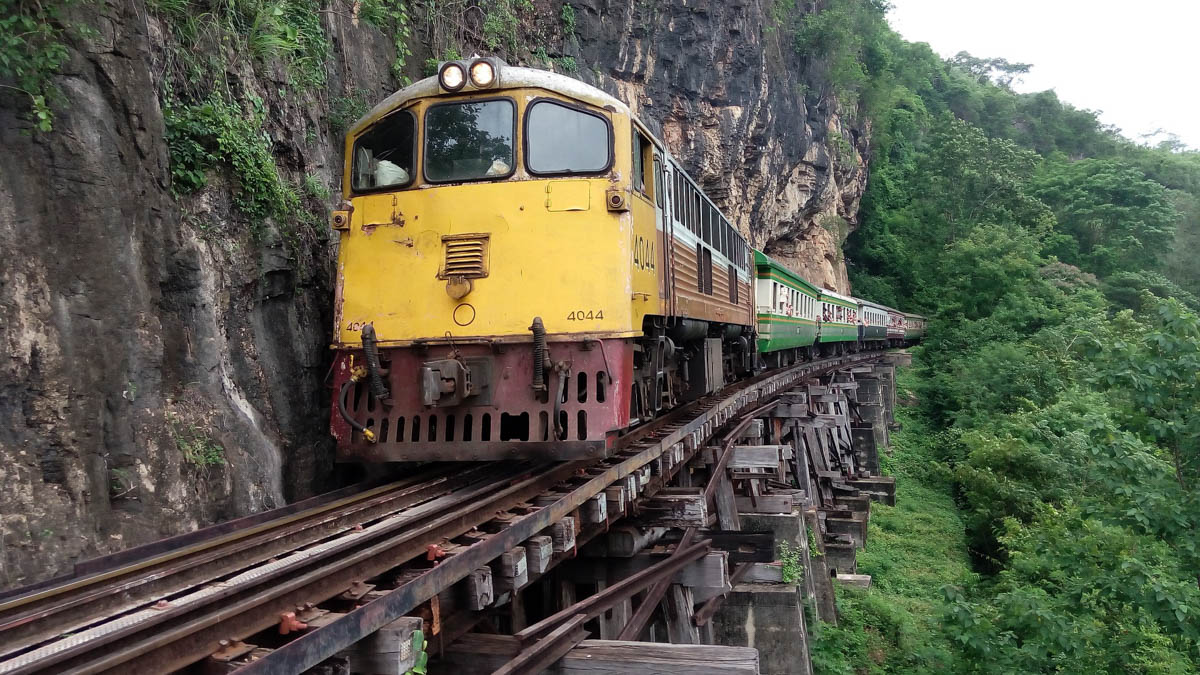
The 90-minute journey today takes you from Kanchanaburi to Nam Tok. You’ll get to cross River Kwai bridge and also the impressive wooden Wampo Viaduct.
The scenery is very picturesque along the way, and although the ride has little to do with the history of the war, you do get to appreciate how long this railway track is.
Trains depart from the platform near Kanchanaburi market. The train starts in Bangkok, but if you only have time to make a day trip from Bangkok to Kanchanaburi, you won’t get the chance to explore the town.
If you’re planning to stay longer than a day, arriving in Nam Tok, Kanchanaburi by train from Bangkok is a great way to start your itinerary.
Hellfire Pass ⭐️
The Hellfire pass was the most challenging section of the Burma Railway to build due to its remoteness and the amount of rock that had to cut away.
Located 80 km from Kanchanaburi in the Tenasserim Hills and named so because of the way it looked when the Prisoners of war worked with torches through the night.
Thousands of men lost their lives here through starvation, dysentery, malaria and other such tropical diseases. The Australian Government opened the museum in 1998, and since then they have cleared much of the overgrown jungle to restore access to the passage.
Hellfire Pass Museum
On entering the museum, you are invited to watch a video about the history of the railway through Hells Passage. Be prepared to get emotional as this sad part of history is shown through the eyes of Tom Morris and Australian ex-prisoner of war. Tom tells of the harrowing conditions these men worked under and explains how they had to cut and chisel there way through the rock by hand.
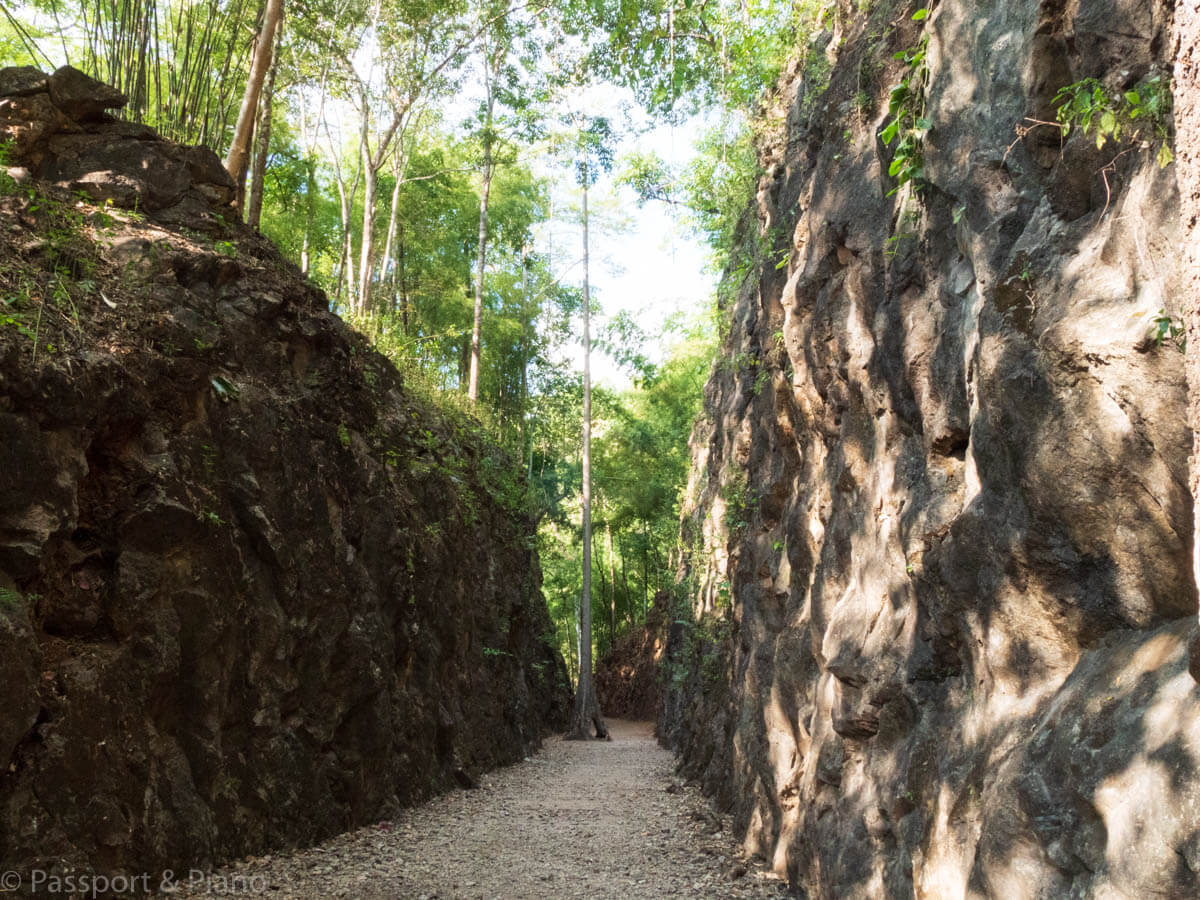
It’s almost impossible to understand how these men coped with the hardship they endured by the Japanese. It’s even more incredible how Tom dared to return to Hellfire pass Thailand in 1984 and locate this section of the railway amid the Jungle. His efforts in ensuring that this piece of history should never be forgotten are more than commendable.
Hellfire Pass walk to the Hellfire pass memorial
Free audio guides accompany you as you walk along the passage. It’s about a 15-minute walk to the Hellfire pass memorial.
As you leave the centre, the atmosphere becomes more solemn as the facades of the rock begin to surround you. It’s almost inconceivable to think that the POW dug this by hand. Although much of the track has been removed and replaced by gravelled path, there are stark reminders of the past everywhere you look.
The end of the first section brings you to the memorial which is where most visitors chose to return. However, if you are physically fit enough and can withstand the heated jungle I highly recommend walking the whole of the pass. Just remember to take lots of water.
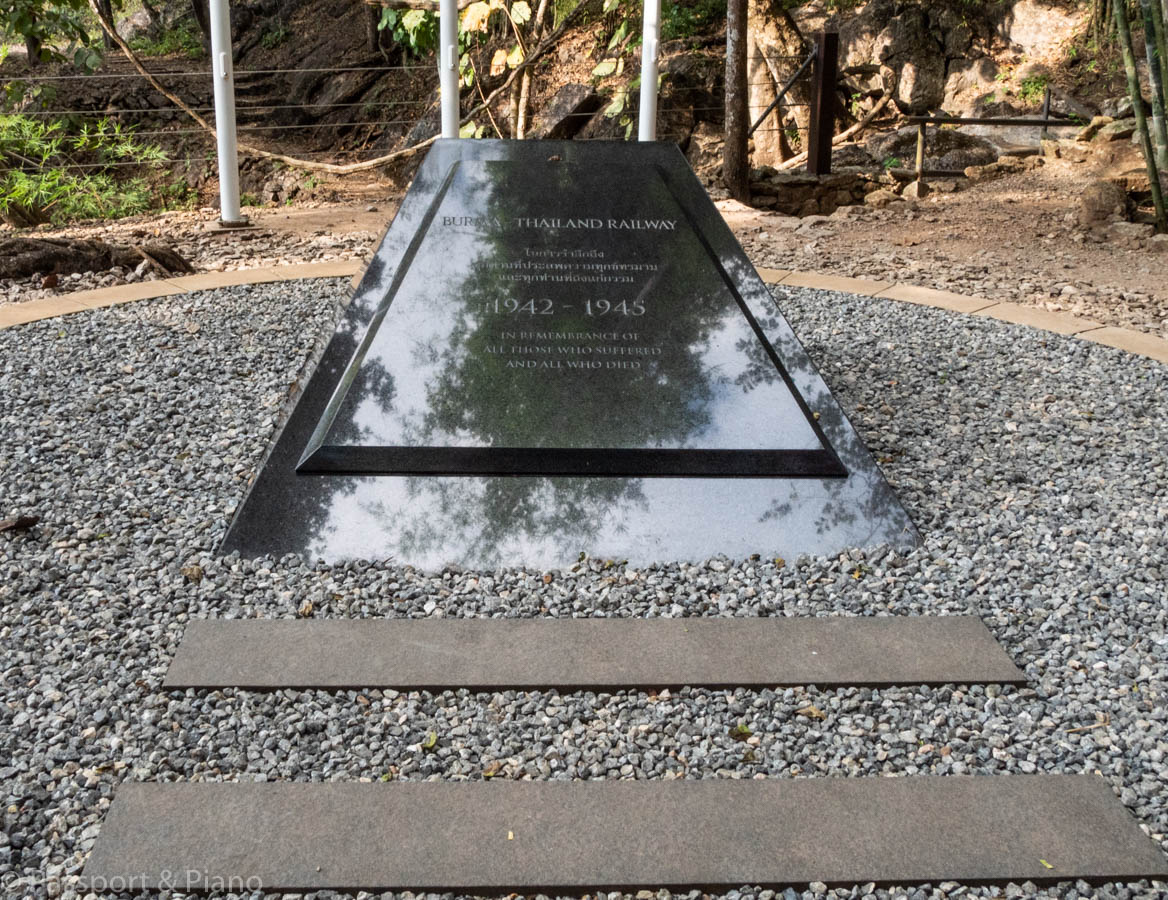
Beyond the War Memorial
The 4km walk takes you from the hellfire pass memorial along a path through the jungle. As I walked the pass, I thought a lot particularly about my grandfather and his time in Burma during the war. I regret not asking him more about it, sadly its too late now.
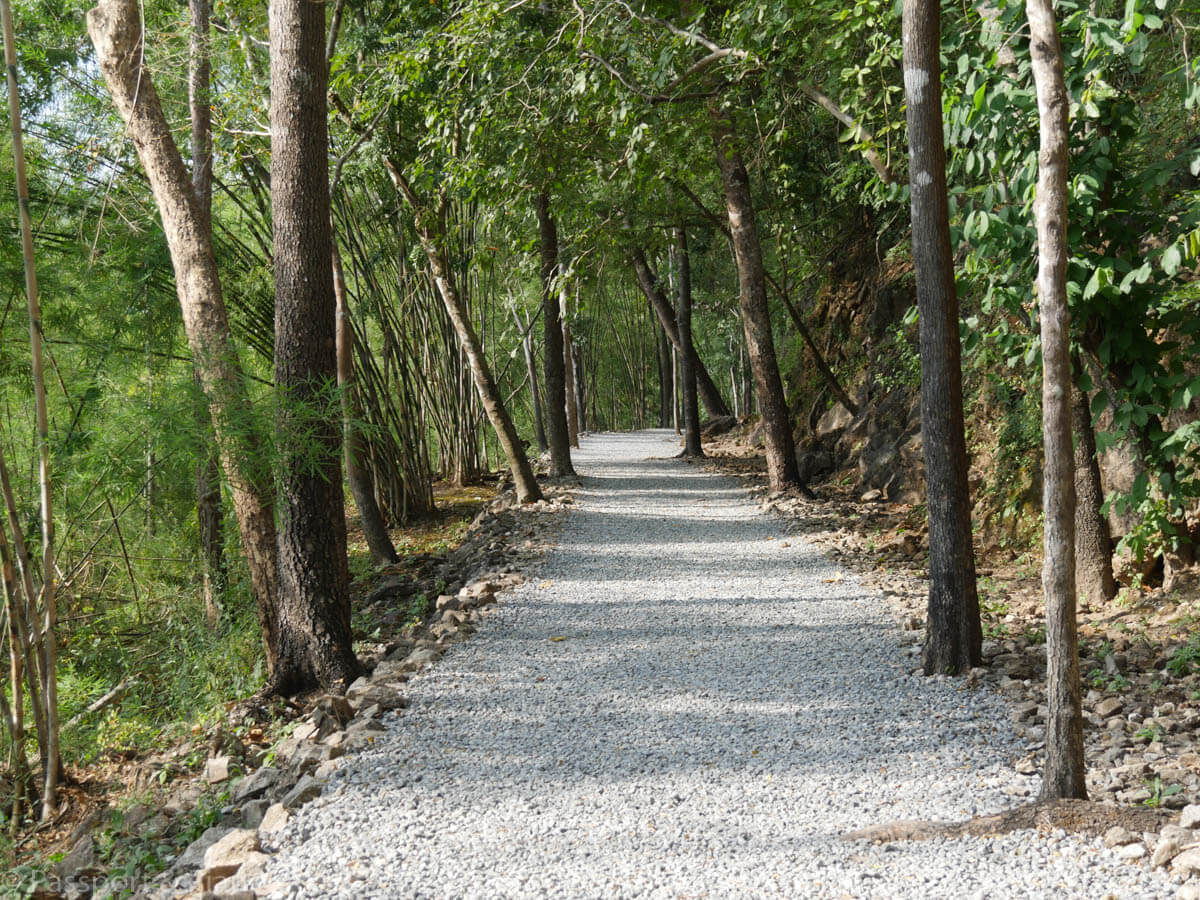
History aside, not that I am belittling it in any way there are some stunning vistas along the way which had it not been for the railway we would not have access to today.
If the whole 4 km pass sounds a little too much, it’s worth walking past the memorial to the Kwae Noi Lookout.
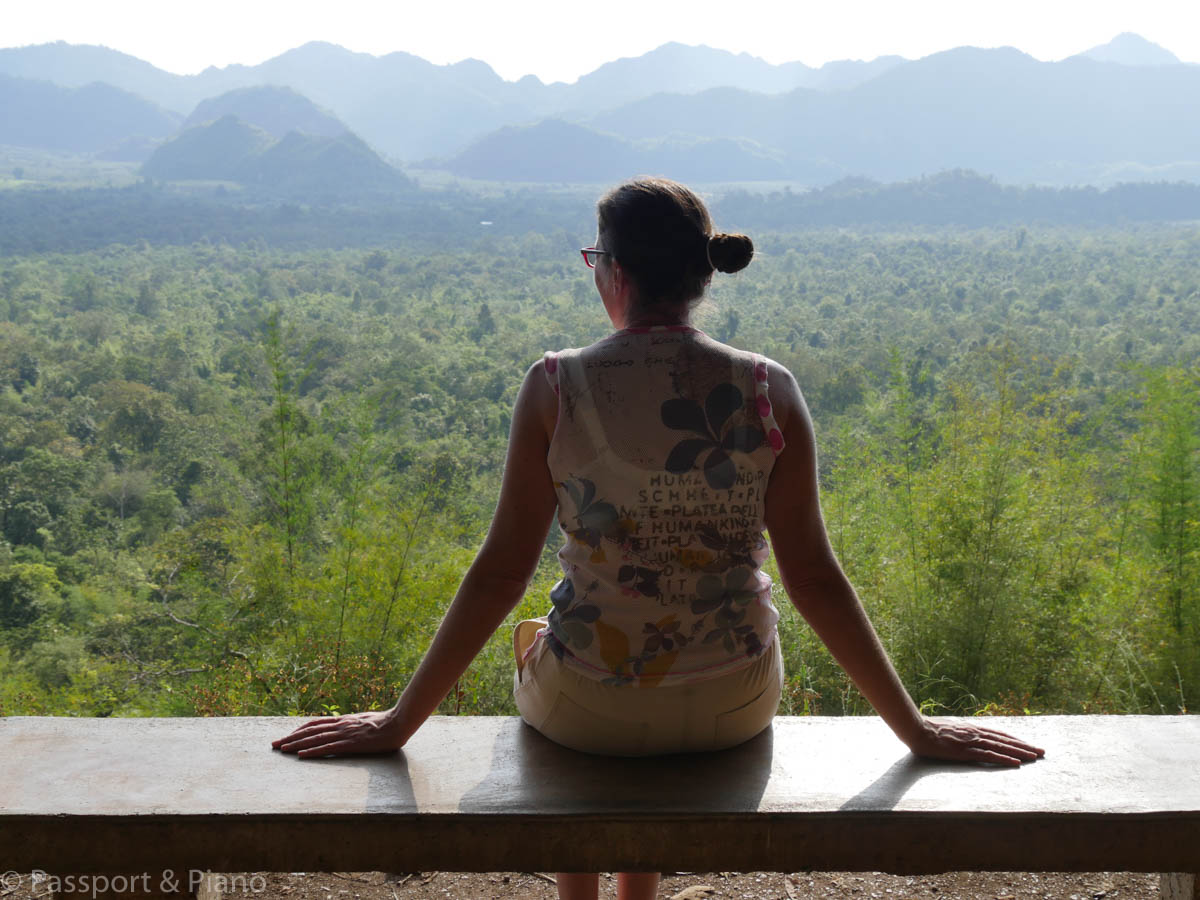
The view here is spectacular, and it’s a great place to go birdwatching and take beautiful photographs, so you might want to pack a pair of binoculars in your backpack.
How to get there?
There are several options to get to Hellfire pass, and one of the things to consider is how long you would like to spend there. If your going to walk the full length of the pass, the follow times and options will prove useful.
Museum to Compressor Cutting return – Allow at least 3 hours.
Museum to Compressor Cutting and back to Hintok Road Pickup – 2.5 hours
Museum to Kwai Noi Lookout return – Allow at least 1 hour
When your planning your own itinerary the easiest way to get to there from Kanchanaburi is by Taxi.
If you hire a taxi for the day, they could drop you off at the Museum, collect you at Compressor Cutting and then take you onto perhaps Sok Noi waterfall. It will cost you approximately 2000Baht to hire a taxi for the day.
The cheaper way is to catch the 8203 bus from Kanchanaburi bus station. Buses run regularly throughout the day and will cost you just 50 Baht.
You can also ride the death railway to Nam Tok and get a taxi from there.
Click here for information on the best place to stay near Hellfire Pass.
Kanchanaburi Waterfalls
Erawan National Park
A visit here is worth putting on your itinerary; the park has the best waterfalls near Bangkok. Erawan National park Thailand is approximately an hours drive from Kanchanaburi in the middle of the jungle.
Erawan Waterfalls ⭐️
The main attraction is the Erawan waterfall which spans over seven tiers and 1500km. Erawan is the name of the three-headed elephant in Hindu mythology, and the 7th level of the falls is supposed to resemble the head.
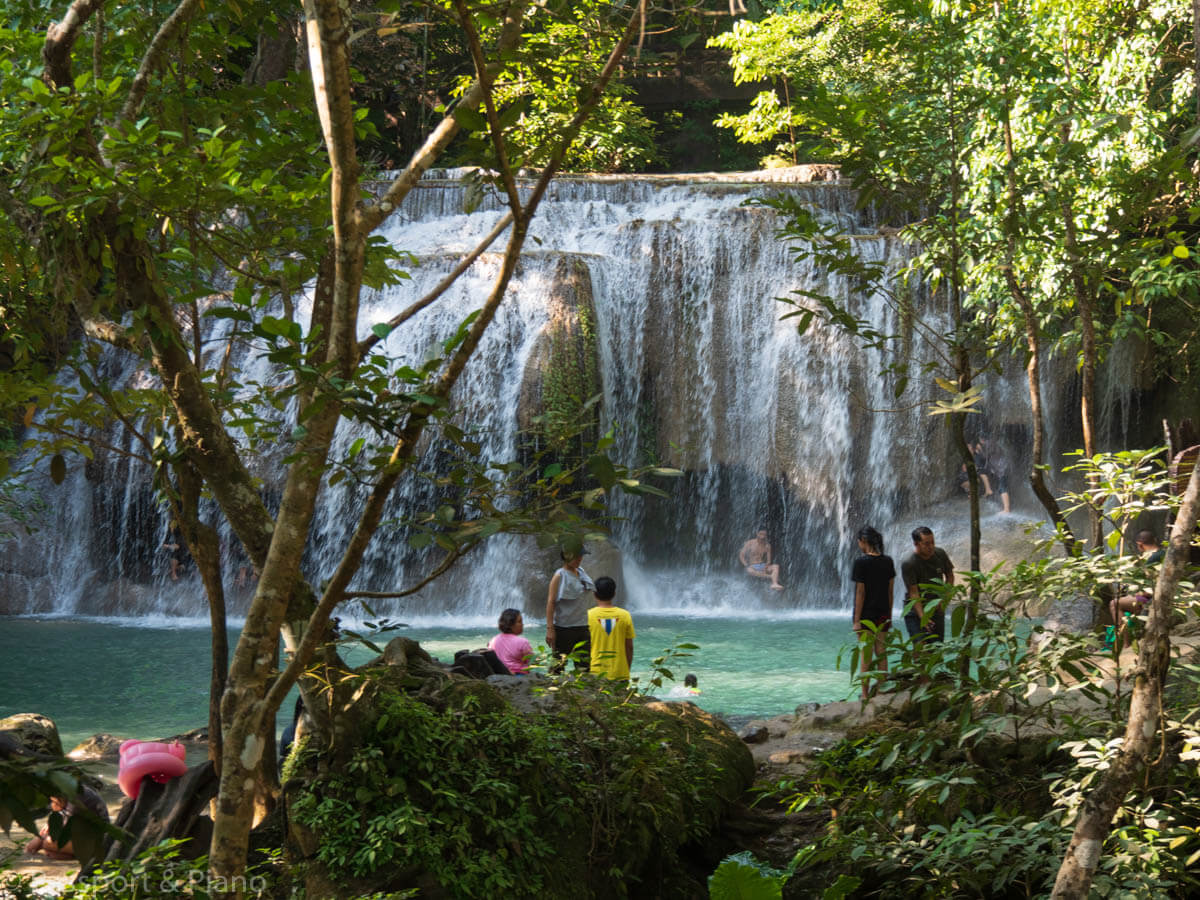
To get to each section, you have to climb through various steps, rocks and terrain.
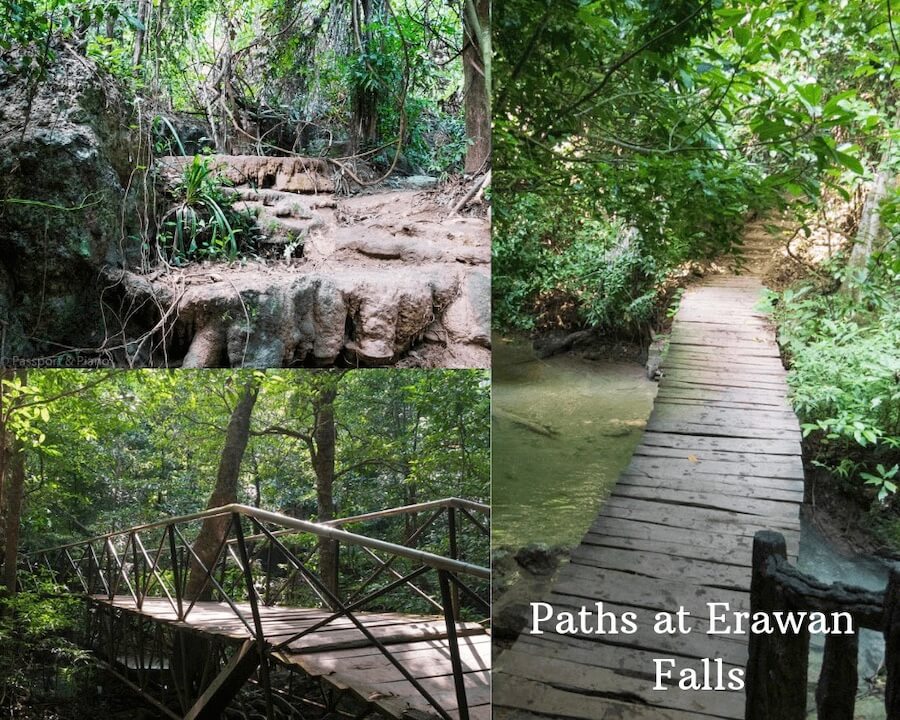
No food is allowed past level one, and if you take a bottle of water with you, you have to leave a deposit and have it marked.
This is an excellent idea as it encourages people to take their plastic with them, albeit not as good as carrying your own reusable water bottle. If you are interested in preserving the environment there are some fantastic water containers available; you can even get collapsible ones that pack in your suitcase.
After the 5th level, the ground becomes more challenging, and you need a good level of fitness to continue. Be prepared to get your feet wet and clamber over large rocks.
Top level waterfall
To enjoy all seven levels you need to spend a full day here, the pools open at 8 am and the earlier you get here, the quieter it is.
After 10 am it starts to become crowded as the day tours arrive.
Tiers 6, and 7 are particularly challenging to get and if your short on time I wouldn’t bother, I’d enjoy relaxing in pools 5 and 6.
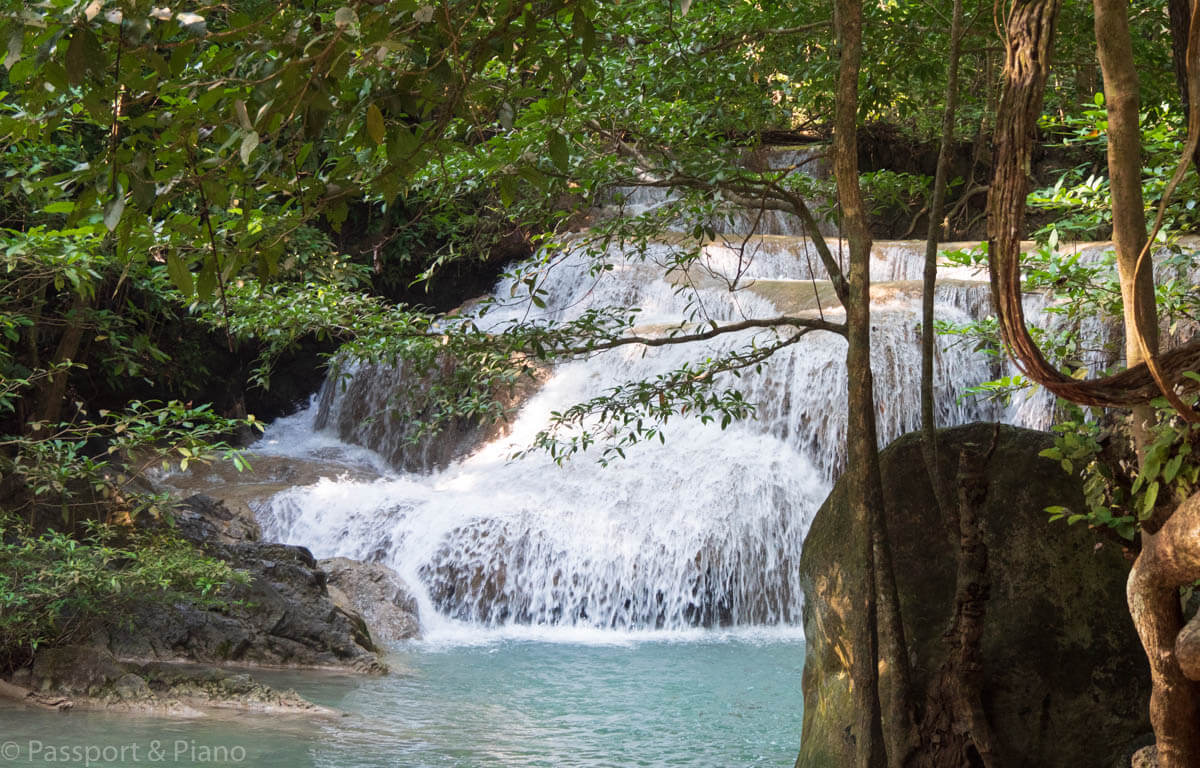
Due to the calcium in the rocks the water is famed for its beautiful turquoise water the temperature of which is most refreshing.
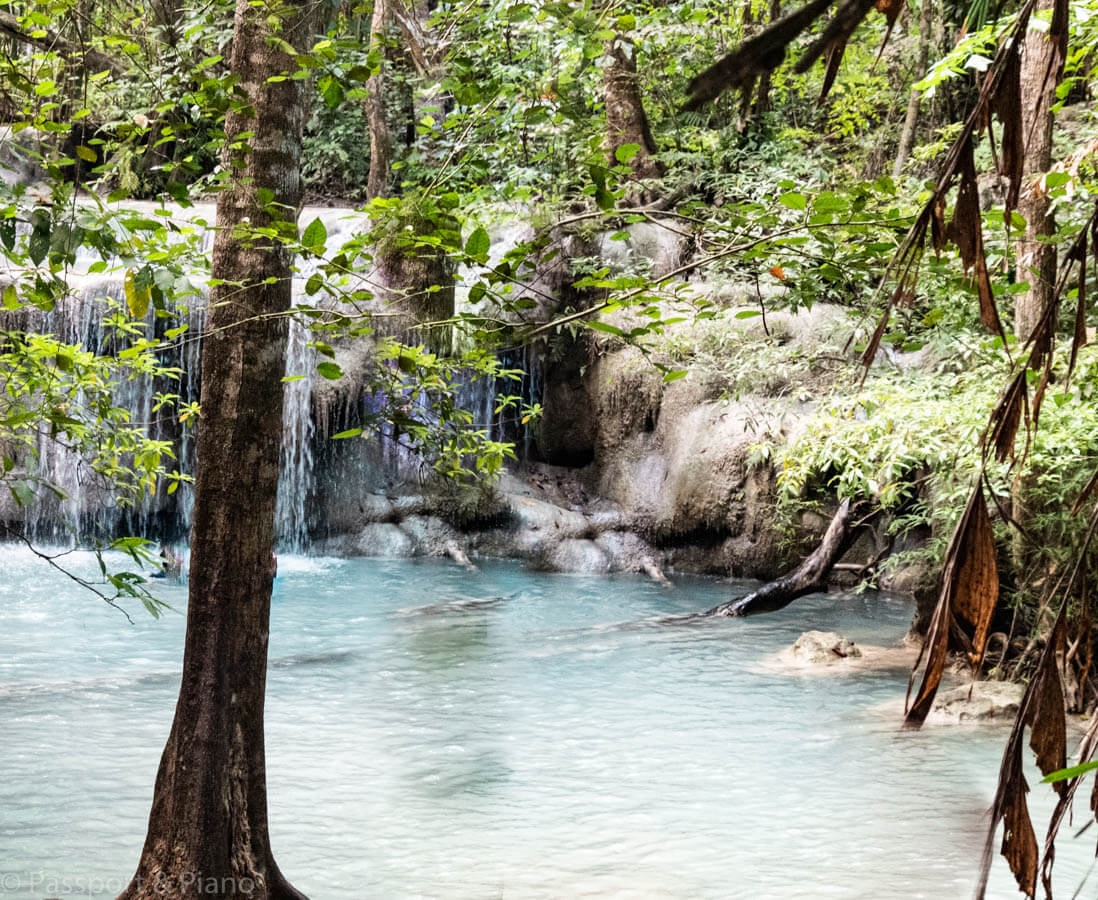
You may be taken by surprise when you swim in it though as the fish can often take a nibble. They don’t hurt, but it is a strange sensation that takes a little getting used to.
Click here for more information about the best hotels near to Erawan Waterfalls
How to get from Kanchanaburi to Erawan Waterfalls
Catch bus 8170 from Kanchanaburi-Erawan National park, it takes 2 hours. A taxi is also possible either from the centre of town or Nam Tok Station, but the easiest way is to pre-book a tour.
Sai Yok Noi Waterfall
Sai yok Noi National Park Kanchanaburi is located approximately 100 km northwest of the city.
The park has several walking trails for you to explore and I’m led to believe that they are well signposted, although I cannot confirm this as I didn’t have the chance to explore.
I did, however, visit the waterfall. It’s not as stunning as Erwanan Falls but its only a km from Nam Tok’s train station.
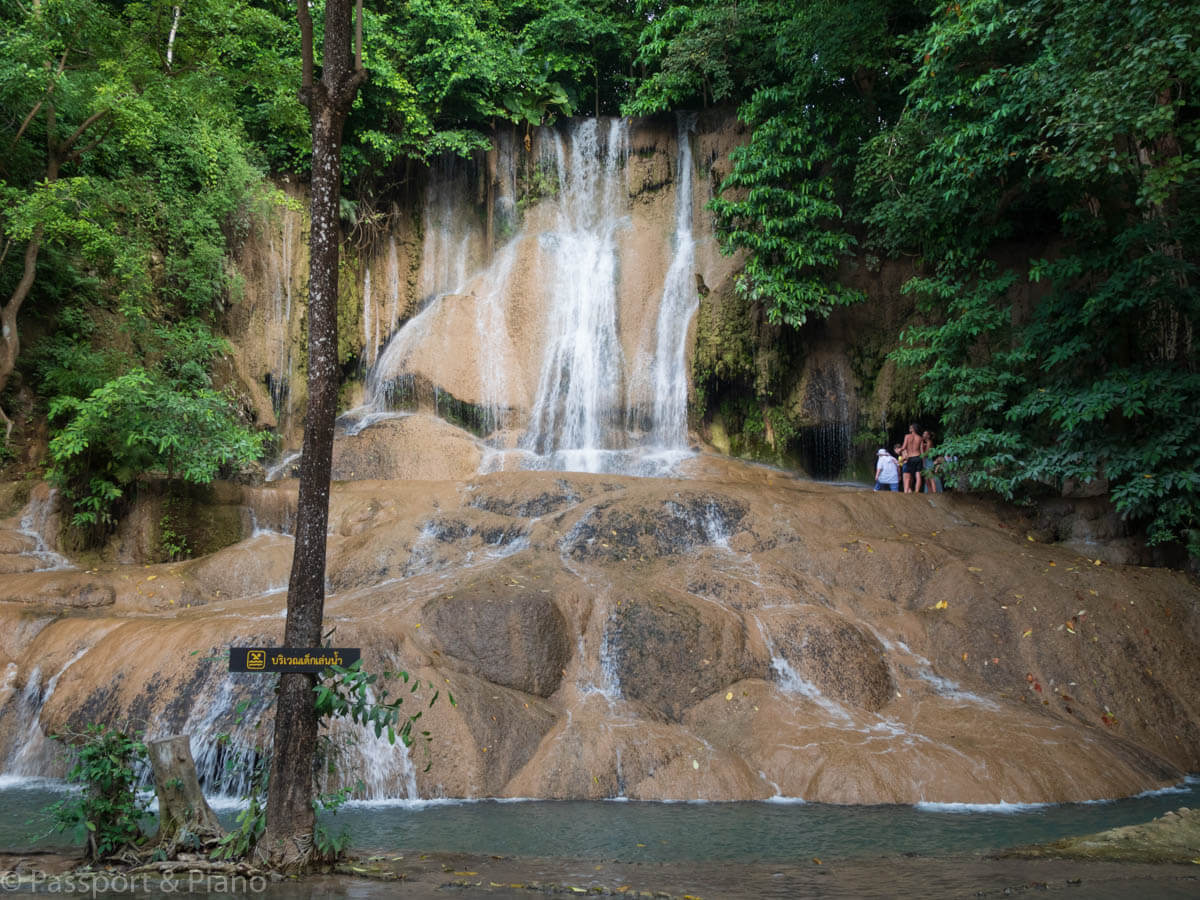
It was reasonably busy when I visited with locals enjoying picnics. There are some interesting food stalls near the car park, so it’s worth buying some snacks to enjoy the waterfall. The local vendors are happy for you to try their delightful fried foods.
Kanchanaburi Temple Caves

There are lots of cave temples in the province of Kanchanaburi, but Krasae Cave which many of these tours visit isn’t the best. It’s a small cave located near the Wampo Viaduct near Thamkrasae Bridge Station. Inside there’s a small Buddha statue and a place of worship.
Tham Krasae Bridge
Tham Krasae Bridge is also known as the Wampo Viaduct. If you ride the Death Kanchanaburi, you’ll go over it on the train. However, few tours actually visit it.
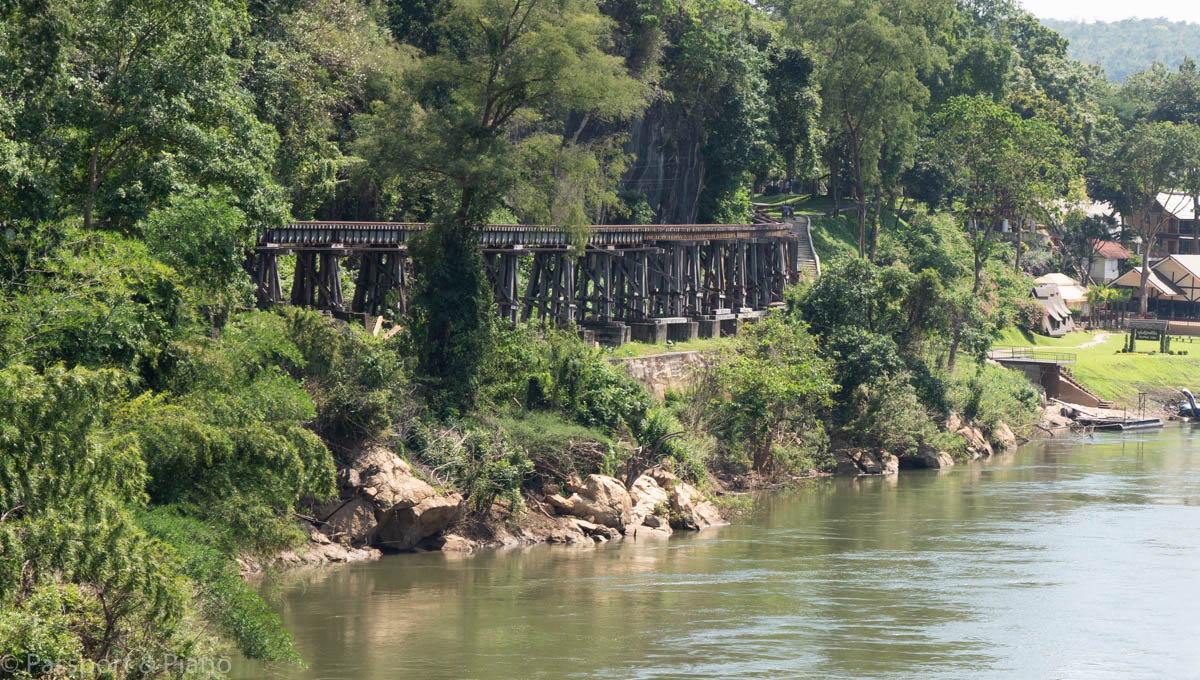
The Tham Krasae Bridge is the only original wooden bridge remaining. It’s another amazing achievement by the POW and well worth a visit. Tours that do go there, will usually include a short walk along the railway line.
Wat Tham Sua
Wat Tham Sua is also known as the Tiger Temple. It is believed that a tiger used to live in the main cave and hence it was given the name Sua which means tiger.
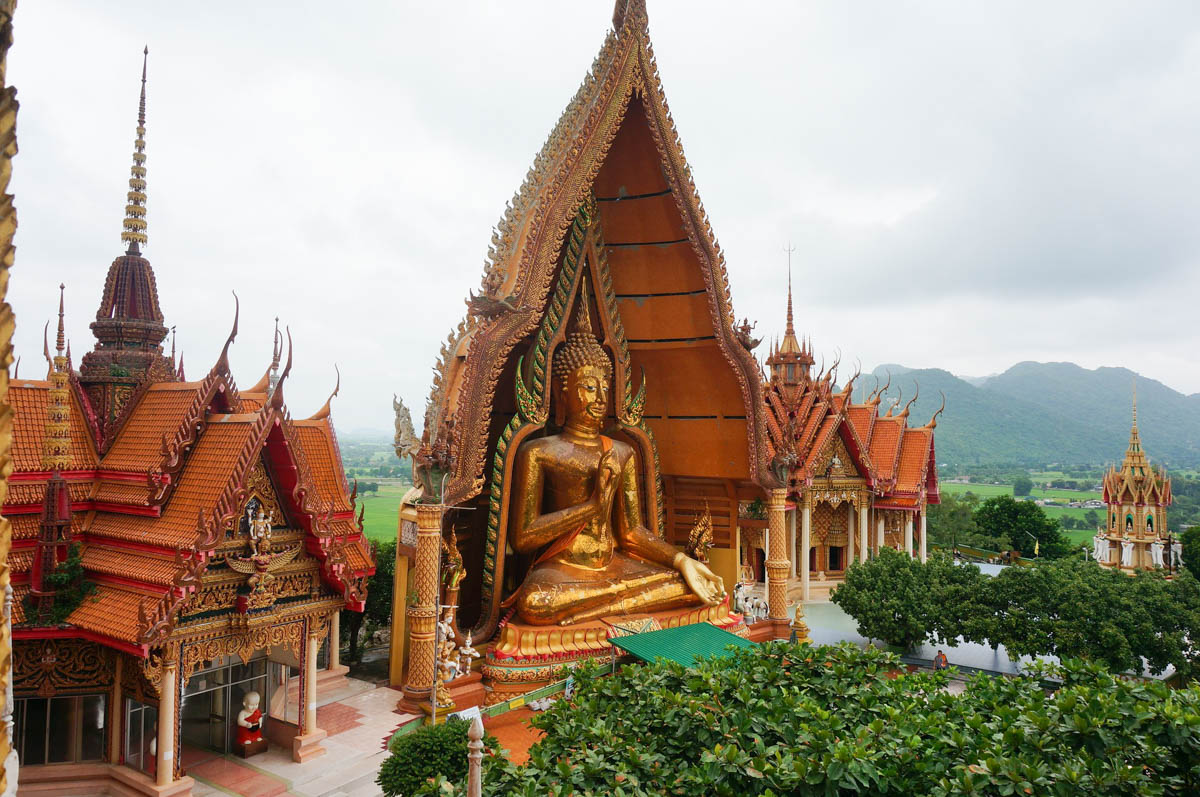
Its approximately 12km from the town and located near the town of Krabi. The highlight of a trip here is the grand Buddha statue known as ‘the Buddha’s footprint’. However, there are 1,272 steps to climb in order to see it.
If you can manage it and withstand the heat, the 360-degree views of the surrounding jungle and Andaman sea are spectacular.
As its a temple you do need to be dressed appropriately to go inside and watch out for the monkeys on the way up. They love to steal your food.
There are no public buses to the temple so if you wish to visit it independently the easiest way to get there is either by songthaew or taxi.
Elephant World Kanchanaburi
Elephant World is one of the better places to go if you wish to see elephants in Thailand. The sanctuary cares for rescued elephants, most of which are injured, old or retired.
They are well cared for and seem to be happy, so why some might say visiting any elephants in Kanchanaburi is irresponsible. I am inclined to disagree. After all, what would happen to these animals if it wasn’t for centres like Elephant World?
The income they earn from visitors pays for the care of the elephants.
Throughout the day here the volunteers will teach you lots about elephants. You can feed and bathe them; it’s a lot of fun. You can spend easily spend a full day there. So if the half-day visits in the day tours above aren’t long enough click here to find out how to arrange an independent visit.
Animal Welfare at other Kanchanaburi elephant parks
Please note that some tours to Kanchanaburi from Bangkok will visit an elephant park. The majority of these call themselves sanctuaries, but they are not. These elephant parks in Kanchanaburi are aimed at tourists, and you’ll see the animals chained in small enclosures and entertaining visitors with circus-like tricks.
Make sure you’re a responsible tourist by not visiting such establishments.
Bamboo Rafting in Kanchanaburi
Made from nothing more than a few bamboo poles strapped together these rafts look primitive at best.
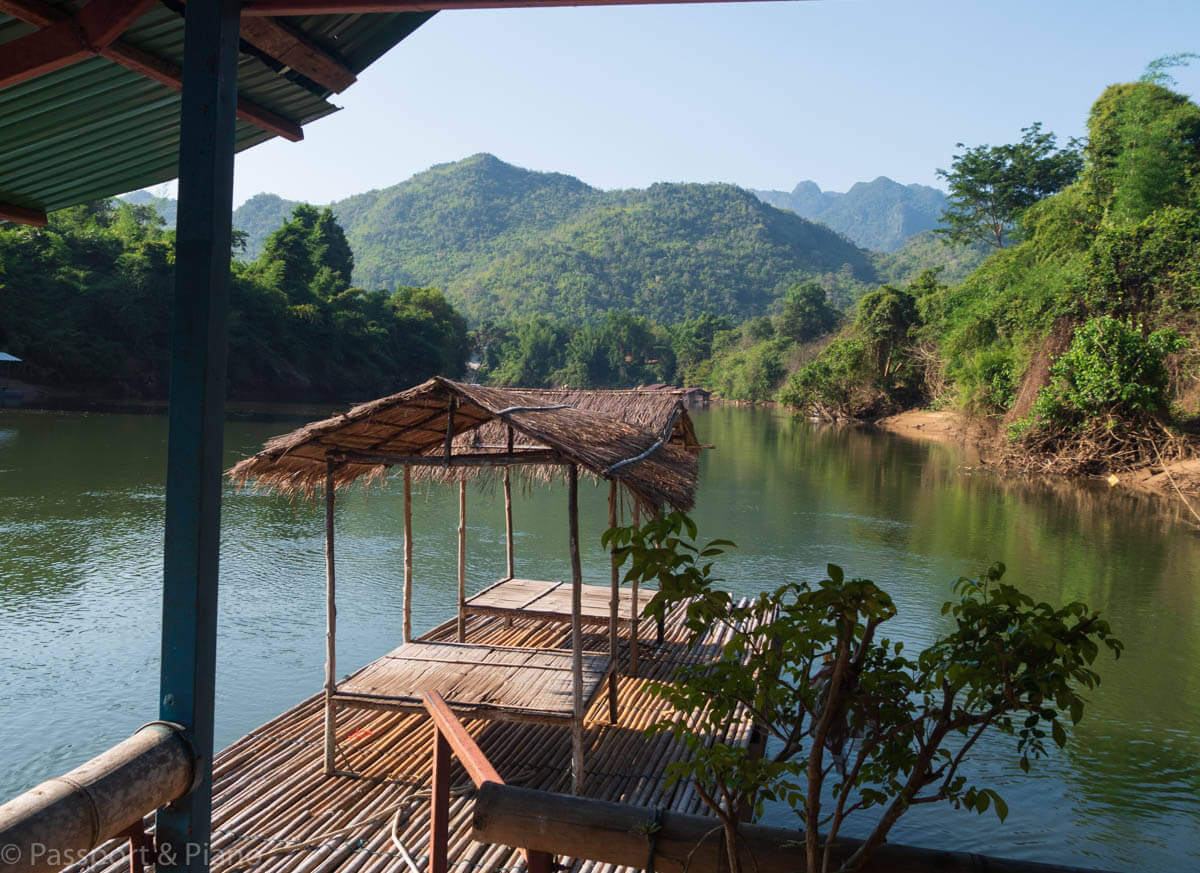
I can say that they serve there purpose well and Kanachaburi rafting is both a relaxing and thoroughly enjoyable way to experience the River Kwai.
The scenery is stunning, and as you drift downstream at a leisurely pace, there’s plenty of time to soak in the vistas. Rafting in Kanchanaburi is popular with the locals, and you’ll often see them fishing as they go.
Mon Village
The mon Village is near the River Kwai Jungle Rafts, Kanchanaburi resort and it’s home to many of the staff that work there.
The Mon was originally an ethnic group from Mongolia who migrated to Burma (Myanmar as its called now). Many have now sought refuge in Thailand in the hope of a better life.
Today many Mon People don’t follow traditions, and their language is becoming less spoken. However, this village is an excellent example of their traditional and simple life.
Yes it has been adapted for tourism, but who can blame them for trying to make a bit of extra income. You’ll find handmade souvenirs and local food to buy.
The village only has a small generator, so many of the residents don’t have electricity. You can wander around freely and your welcome to visit the school, the temple and the traditional houses on stilts.
The scenery around the village is stunning, and I found the insight into their culture very interesting.
Kanchanaburi Hot Springs – Hin Dad Hot
The Hin Dad Hot Springs are popular with locals who believe the water contains healing properties. The Japanese army discovered them during the second world war. There are three natural pools to relax in and the water temperature
The springs are 20km south of Thong Pha Phum approximately 130km from Kanchanaburi. If you want to visit independently, you can get there on the Sangkhlaburi–Kanchanaburi bus. The entrance fee is 10 Baht. However, if time is limited, I would prioritise Erawan waterfalls.
Unfortunately, I have not visited Pung Waan Spa, but I believe they offer an excellent range of spa treatments.
Places visited on route to Kanchanaburi from Bangkok
Floating markets are popular with tourists throughout Thailand, but the best time to visit them is early in the morning. Hence why several tours to Kanchanaburi stop at one of Bangkok’s most popular on the route.
Damnoen Saduak Floating Market
The Damnoen Saduak Floating Market is a maze of narrow canals which you can explore on a long tail boat.
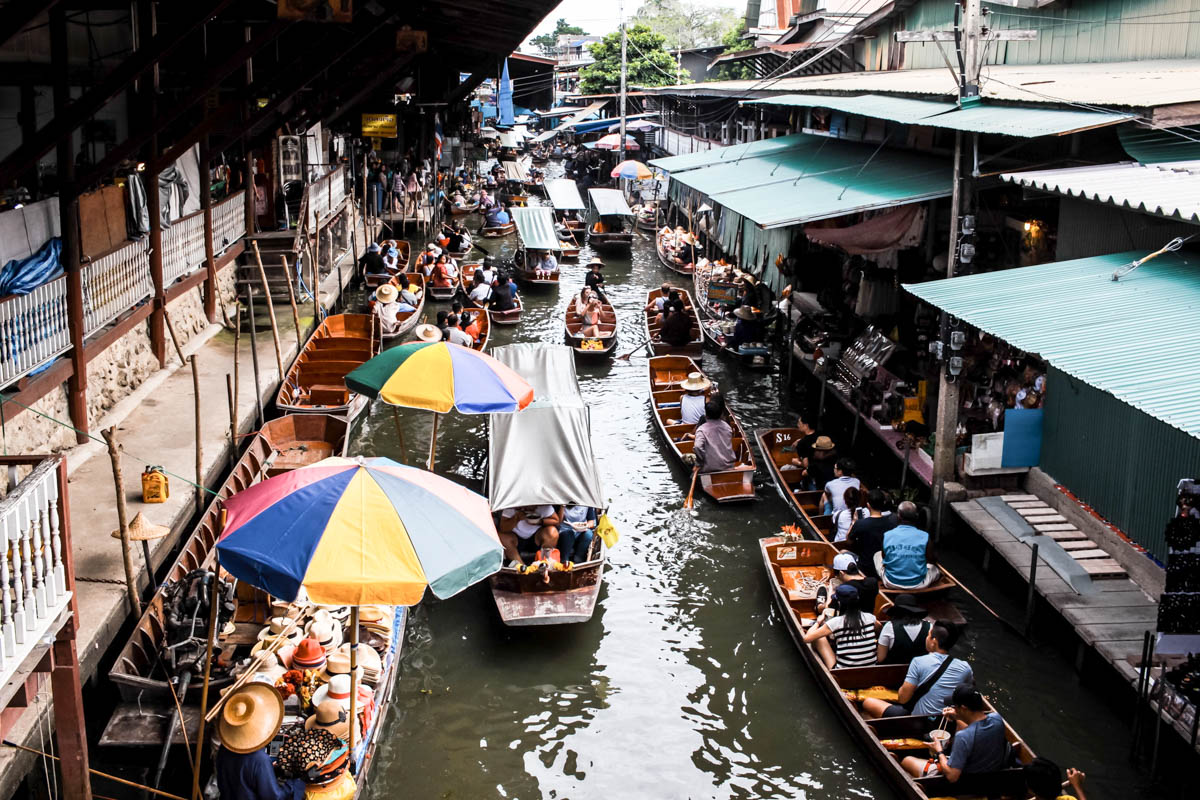
Its a vibrant and busy place with female traders often dressed in traditional attire. You’ll find plenty of souvenirs to purchase here, however, to get the best prices you will need to haggle.
Unfortunately, the market has become a bit of a tourist trap, but you can get some delicious Thai bites cooked by locals.
Damnoen Saduak floating market is over an hour away from the centre of Bangkok, and although you can catch a bus there, it’s much easier to take a tour.
FAQ about Kanchanaburi, What To Do and How to Get There
What’s the distance from Bangkok to Kanchanaburi?
The distance to Kanchanaburi from Bangkok is approximately 140km. It takes around 3 hours to travel by minibus or taxi from Bangkok to Kanchanaburi. This includes a short coffee break.
What is the River Kwai Resotel like?
The hotel is on the edge of Sai yok National Park and within walking distance of Lawa Cave. The surrounding gardens are beautiful, and each room has a balcony so you can soak up the vistas of the lush jungle vistas.
There is an onsite restaurant and a swimming pool, which makes it a great choice if you’re looking for a Kanchanaburi to Bangkok family tour. You can read more about the hotel here on Trip Advisor.
What is the accommodation like at the River Kwai Jungle Raft Kanchanaburi?
If you want to experience a bamboo guest house and floating hotel in Kanchanaburi, you’ll love Jungle Rafts.
The location in the heart of the Sai Yok National Park on the river is truly stunning, but be warned there’s not a lot to do. The rooms are basic, and there’s no electricity.
Oil lamps provide the only lighting and there’s very little hot water. That said, I thoroughly enjoyed my stay here. It was so tranquil and peaceful that it made a refreshing change to modern life. You can read other peoples reviews here.
Can I catch the train to Kanchanaburi from Bangkok?
Trains run from Bangkok to Kanchanaburi twice a day, departing at 07:50 and at 13:55 from Thonburi station. This is not the central station in Bangkok, and it is a little tricky to get to.
The easiest way is to get the ferry to Thonburi Railway pier and from there its just a short walk to the station. The journey takes approximately 2 and a half hours; however, there are often delays on Thai trains.
The Bangkok to Kanchanaburi train stops before it crosses the River Kwai bridge. However, the same train does continue along the Kanchanaburi railway line so if you want to cross the bridge buy a ticket to Nam Tok.
For your return journey, the train from Kanchanaburi to Bangkok departs at 07:19 and 14:48.
Is there a bus from Bangkok to Kanchanaburi?
Catching the bus to Kanchanaburi is not something I’d recommend, but it is possible.
The journey takes approximately 3-4 hours, and the buses from Kanchanaburi to Bangkok depart from Bangkok Southern Bus Terminal (Sai Tai Mai).
Apart from this being the slowest method of transport the bus station in Kanchanaburi is about a 20-minute walk to the main attractions.
Is there a tour that doesn’t charge supplements for single travellers?
The tour company Kitty Raft offers day trips and 2/3 night itineraries for backpackers. I have taken a tour with them, but it’s not one I’d recommend.
The accommodation was very basic although the bamboo guesthouse was in a stunning location. The guides were not fantastic either, but at 5000Baht for three nights it does offer excellent value.
Many of the tour companies around Khao San Road use this company for their tours to Kanchanaburi.
I hope you’ve found this guide to Kanchanaburi helpful. Due to the distances between attractions, it is easier to participate in a Bangkok tour to Kanchanaburi than travel by yourself particularly if you don’t have much time. Any tour, of course, will mean a compromise, but the convenience of having a tour guide, transport and accommodation arranged for your makes a River Kwai tour or visit to the province worthwhile.
You may also find this article in the best hotels in Kanchanaburi of interest if you would prefer to visit the area independently.

